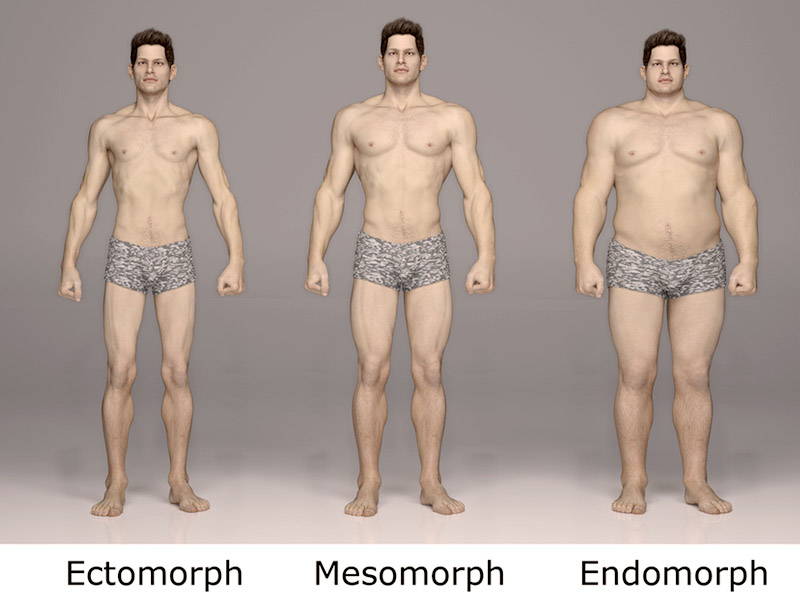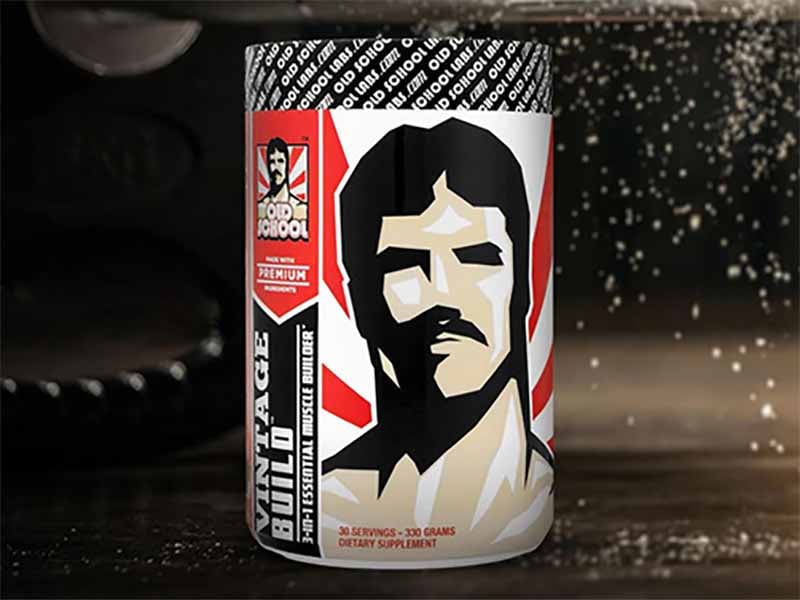
Ectomorph Body Type: Guide to Bodybuilding & Diet
Key Takeaways
- Your body type, or somatotype, influences your ability to build mass and lose fat. Depending on your body size and composition, you can be a mesomorph, endomorph, or endomorph. Most individuals have characteristics of two or three somatotypes.
- Ectomorphs are tall and slender, with a delicate build and long limbs. Due to their fast metabolism, they have trouble gaining muscle.
- If you have an ectomorph body type, it’s critical to get enough calories and train for size. Nutrient-dense foods are your best bet. Avoid empty calories and fill up on lean meat, nuts, seeds, fatty fish, and whole grains.
- Sports supplements are particularly for ectomorphs, allowing them to get more calories and fill nutritional gaps. Weight gainers, protein shakes, creatine, L-glutamine, and BCAAs should come first on your list.
Have trouble building mass despite bulking up and spending hours in the gym? Would you do anything to have a wider chest and back or bigger arms? Then it might be time to change your approach to diet and training.
Your ability to gain mass depends a lot on genetics. Some people are genetically gifted with strong, muscular bodies, while others have a thin frame and find it hard to gain weight. These characteristics are due to the differences in body size and composition.
Back in the 1940s, William H. Sheldon, Ph.D., introduced the concept of somatotype, or body type. These include ectomorph, endomorph, and mesomorph.

Each somatotype has distinct characteristics. The ectomorph body type, for example, is naturally lean and lightly muscled.
Sheldon believed that body composition influences personality and behavior and that a person’s somatotype cannot be changed. However, these theories haven’t been accepted by the medical community.
As the National Academy of Sports Medicine (NASM) notes, no one is predetermined to be skinny, muscular, or fat.
Although you can’t change your somatotype, you can take the steps needed to lose fat, build muscle, or both. Additionally, it’s your physiological characteristics that determine your body type, not the other way around.
Today we’ll discuss how to eat and train for an ectomorph body type. Our team will show you how to add size to your frame and what your diet should look like.
Let’s get into it!
What’s Your Somatotype?
Athletic performance depends largely on somatotype. For example, a 2013 study suggests that most football players are mesomorphs. The same goes for soccer players, swimmers, wrestlers, and other athletes who look well-built.
Mesomorphs are naturally muscular, with a narrow waist, wide shoulders, and low body fat. They can easily lose or gain weight and have the ability to build mass without much effort.

Ectomorphs, on the other hand, are naturally slender, with a narrow back, flat chest, and delicate bones. We all have that one friend who can eat everything in sight without gaining a pound. Building muscle is just as difficult for those with an ectomorph body type.
Endomorphs are at the opposite end of the scale as they tend to store fat easily.
Due to their sluggish metabolism, they tend to have fuller figures and find it difficult to lose weight. This body type is characterized by a large bone structure, wide hips and shoulders, poorly developed muscles, and short arms.
Most people have characteristics of two or three somatotypes. There is no such thing as a “pure” somatotype, according to the NASM. Furthermore, the way you look is largely determined by your diet, training routine, and lifestyle habits — not just your genetics.
Ectomorphs, for example, are supposed to be lean, but that’s not always the case.
An ectomorph who spends most of his time on the couch and binges on junk food is unlikely to be healthy or lean. He might actually have more body fat than an endomorph who eats clean and engages in regular exercise.
Your somatotype isn’t a life sentence. There are steps you can take to reach your training goals and improve body composition. As an ectomorph, it’s important to gradually increase your energy intake and train for hypertrophy, or muscle growth.
Characteristics of the Ectomorph Body Type
Being an ectomorph isn’t easy. Sure, you can eat a wide range of foods without gaining weight, but that could work against you. A diet rich in sugar and trans fats foods may increase your risk of heart disease, diabetes, cancer, and inflammatory disorders.
Ectomorphs have a fast metabolism, explains the American Council on Exercise. As a result, they burn more calories throughout the day compared to the average person. That’s a double-edged sword, though.
On one hand, you don’t have to worry about weight gain. On the other hand, you may find it difficult to build muscle and maintain a healthy weight. That’s why ectomorphs are often referred to as “hardgainers.”
Those who fall into this category tend to have relatively small muscles, narrow hips and shoulders, thin bones, and long limbs. In general, they are tall and slender, with low body fat. Their light frame makes them susceptible to injury.

Ectomorphs perform best at gymnastics, dance, and endurance sports, such as cycling and long-distance running. Other sports, like tennis and basketball, are a good choice too.
Bodybuilding and powerlifting, on the other hand, may pose challenges for those with an endomorph body type.
Usain Bolt, Michael Phelps, Lance Armstrong, and other endurance athletes are all ectomorphs. The same goes for famous bodybuilders like Flex Wheeler and Frank Zane. Therefore, it’s not impossible to reach peak performance just because you’re on the lighter side.
As the NASM notes, ectomorphs can improve their body composition through diet and training. The key is to focus on maximizing muscle protein synthesis. This brings to the next point…
Increase Your Energy Intake
Hypertrophy requires an energy surplus, meaning that you must take in more calories than you burn. But this strategy can also lead to fat gain. As an ectomorph, you want to gain weight fast without getting fat.

One way to maximize lean mass gains is to go on a clean bulk. Our guide to bulking versus cutting is a good starting point, so check it out.
First, determine your current calorie intake. Keep a food log and write down what you eat or use an app like MyPlate Calorie Counter to track your food and calculate your macros. See our guide on how to count macros based on your training goals.
Next, try to estimate your energy requirements. Weight Management: A Practitioner’s Guide suggests using the following formula to calculate your basal metabolic rate (BMR):
18-29 Years
- Men: 15.1 x weight (kg) + 692
- Women: 14.8 x weight (kg) + 487
30-59 Years
- Men: 11.5 x weight (kg) + 873
- Women: 8.3 x weight (kg) + 846
60+ Years
- Men: 11.9 x weight (kg) + 700
- Women: 9.2 x weight (kg) + 687
Multiply the result by 1.4 if you have a sedentary lifestyle or 1.5 if you engage in light exercise. Those who work out regularly should multiply their BMR by 1.78 (men) or 1.64 (women). These numbers are higher for athletes, respectively 2.1 for men and 1.82 for women.
The result represents the minimum number of calories you must consume in a day to maintain your weight.
To build mass, increase your energy intake by about 500 calories a day, as recommended by the American Council on Exercise. Get at least half of your calories from carbs, 25% from protein, and the remaining 25% from fat.
Go on a Clean Bulk
Just because you’re trying to gain weight doesn’t mean you should binge on pizza and cookies. You still need to follow the rules of workout nutrition and keep an eye on your macros.

Fill up on nutrient-dense foods that provide your body with quality protein, heart-healthy fats, and complex carbs. Meat, fatty fish, nuts, whole grains, legumes, sweet potatoes, quinoa, and brown rice are all a great choice.
Here are some examples:
- Wild Atlantic salmon (raw) — 121 calories, 16.9 grams of protein, and 5.4 grams of fat per serving (3 oz)
- Atlantic mackerel (raw) — 230 calories, 20.8 grams of protein, and 15.6 grams of fat per serving (1 fillet)
- Beef steak — 228 calories, 24.4 grams of protein, and 14.5 grams of fat per serving (3 oz)
- Baked sweet potatoes — 162 calories, 37.3 grams of carbs, 3.6 grams of protein, and 0.3 grams of fat per serving (1 large potato)
- Brown rice (cooked) — 109 calories, 22.9 grams of carbs, 2.3 grams of protein, and 0.8 grams of fat per serving (1/2 cup)
- Walnuts — 186 calories, 3.9 grams of carbs, 4.3 grams of protein, and 18.5 grams of fat per serving (1 oz)
- Macadamia nuts — 104 calories, 3.9 grams of carbs, 2.2 grams of protein, and 21.5 grams of fat per serving (1 oz)
- Pumpkin seeds (raw) — 151 calories, 4.7 grams of carbs, 6.6 grams of protein, and 12.3 grams of fat per serving (1 oz)
- Sunflower seeds (roasted) — 165 calories, 6.8 grams of carbs, 5.5 grams of protein, and 14.1 grams of fat per serving (1 oz)
As a “hardgainer”, it’s essential to get the most nutritional bang for your bang. If you’re binging on empty calories, you’ll end up gaining fat, not lean mass. Simply put, you have to eat to grow.
Fill the Nutritional Gaps in Your Diet
A balanced diet doesn’t necessarily provide all of the nutrients required for optimal health. Most foods lose nutrients during processing, storage, and transportation, making it difficult to meet your nutritional needs.
On top of that, athletes — especially those with an ectomorph body type — have higher nutritional requirements.

When you’re bulking up, it’s fairly easy to get enough protein, carbs, and fats. But you also need vitamins and other micronutrients that support sports performance and muscle growth.
Consider taking a multivitamin and mineral formula to fill in small but critical nutritional gaps.
This preventive measure may help lower your risk of osteoporosis, anemia, and other conditions, according to current evidence. Furthermore, vitamin B12 and other micronutrients have a direct impact on physical performance.
Supplements that Promote Muscle Growth
Next, look for sports supplements that promote muscle growth and repair.
Protein powder, creatine, L-glutamine, and BCAAs are all a viable option. Creatine monohydrate, for instance, stimulates hypertrophy and increases muscular strength when combined with resistance training.
Vintage Build™, our signature muscle builder, combines creatine, L-glutamine, and BCAAs to help you make gains. This combo of amino acids & creatine is critical for post-workout recovery, muscular development, and athletic performance.
Better yet, try our Size & Strength Stack, which provides everything you need to get big. All of our products are free of GMOs and fillers and only contain tried-and-tested ingredients.
If you have trouble eating enough, add a weight gainer to the mix. Commercial mass gainers are loaded with sugar and other bad stuff, which is why we don’t recommend them.
Instead, combine protein powder with dextrose, peanut or almond butter, oats, or mashed bananas to boost your energy intake.
Two or three of these shakes per day will add over 2,000 calories to your diet. Plus, they’re easy to digest, fueling your muscles quickly.
Lift Big to Get Big
As far as training goes, ectomorphs need to cut back on cardio and prioritize heavy lifting. The American Council on Exercise recommends no more than 30 minutes of cardio three times per week.
An ectomorph workout program should consist of heavy compound movements, with two or three minutes of rest between sets.
Focus on the major muscle groups and keep isolation work to a minimum. Make sure your training routine includes bench presses, leg presses, barbell back squats, lunges, deadlift variations, and other heavy lifts.

Depending on your preferences, you can opt for a push/pull routine, pyramid sets, supersets, negative reps, and so on. Check out this muscle-building routine for inspiration.
We’re not saying that you should forget about cardio and focus solely on weight lifting. If you enjoy biking or swimming, go ahead and continue in your sport. Just make sure you don’t go overboard.
Ectomorphs have a fast metabolism. Cardiovascular training further increases your calorie burn, and that’s the last thing you want when you’re trying to gain weight. Heavy lifting, on the other hand, promotes hypertrophy and boosts testosterone levels, leading to mass and strength gains.
Optimize Your Diet and Training for Maximum Muscle Growth
Being a skinny guy can be a disadvantage when it comes to building mass, but this shouldn’t keep you from pursuing your training goals.
Load up on nutrient-dense foods, increase your energy intake, and go heavy in the gym. Use free weights rather than gym machines and prioritize compound movements.

Remember that more isn’t always better. Keep your workouts short, get plenty of rest, and do minimal cardio. Consider starting an old school bodybuilding workout program to add size to your frame.
As far as your diet goes, try to eat more frequently and never miss a meal. Fuel your body every two or three hours to get enough calories and prevent muscle breakdown. Fill up on weight gainers, protein shakes, and nutrient-dense snacks to meet your caloric needs.
Do you have any tips for an ectomorph body type? Perhaps you’d like to share your diet or training plan for gaining mass? Let us know in the comments section below!









